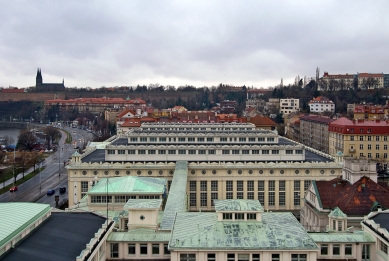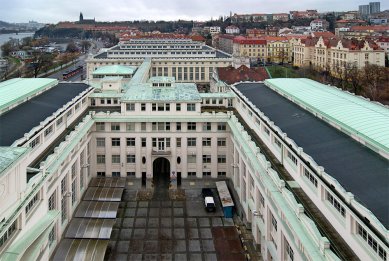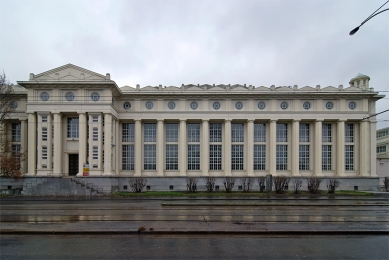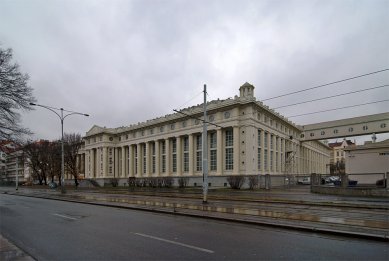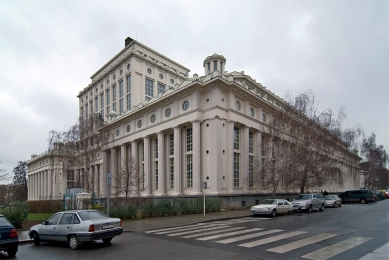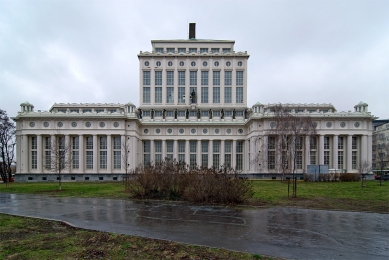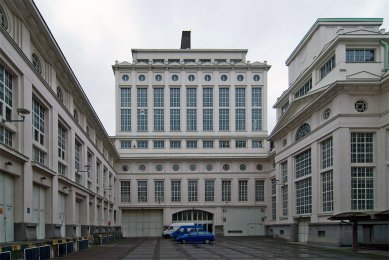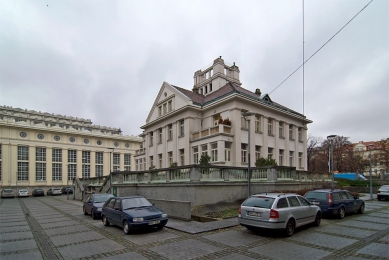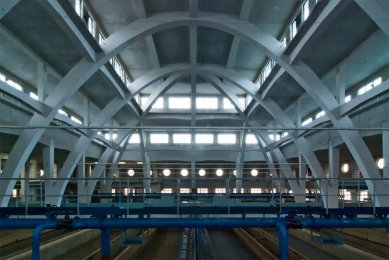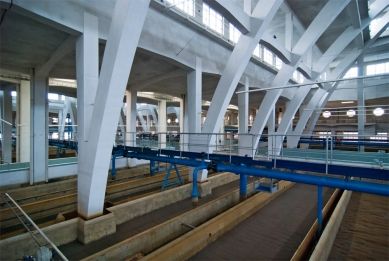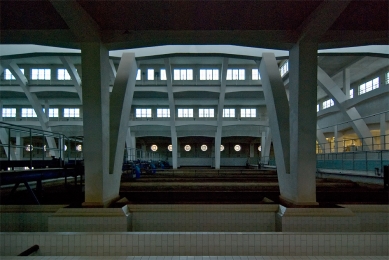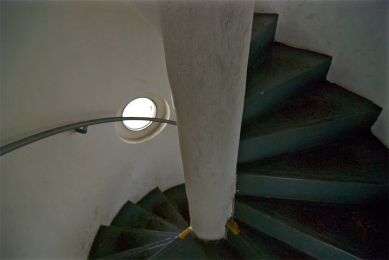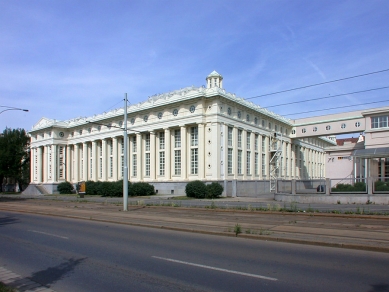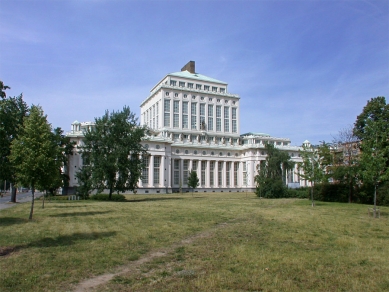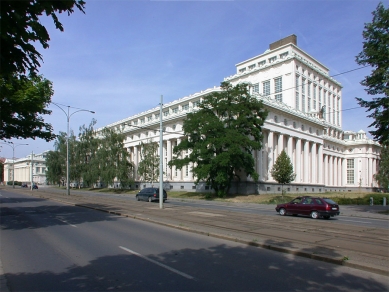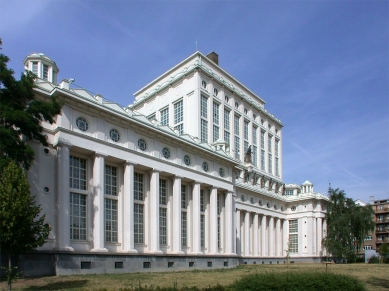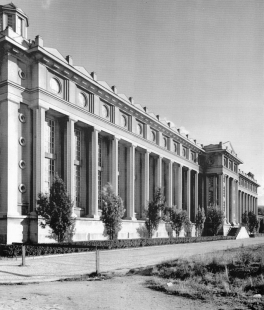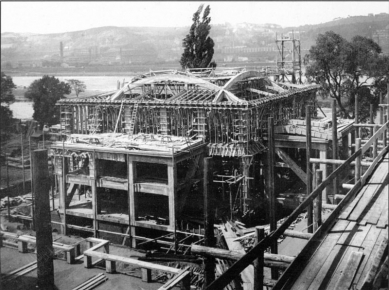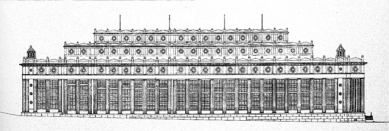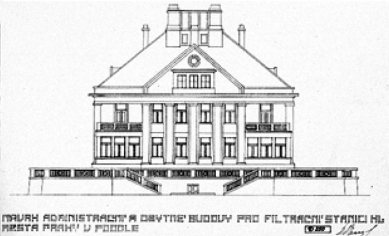
Podolska Waterworks
Waterworks and Filtration Station in Prague-Podolí

At the beginning of the 1920s, the waterworks in Kárané, completed in 1914, supplied the Prague water supply network. After the establishment of Greater Prague in 1922, the capital became a metropolis with more than half a million inhabitants, and it was necessary to establish a new source of drinking water.
For this purpose, a new waterworks and filtration station in Podolí was built between 1922 and 1929, located on the right bank of the Vltava at the site of the Prague waterworks, which existed here from 1885 to 1922. The author of the architectural-urban design was Antonín Engel, who won the competition with a project in the spirit of monumental classicism. The roofing of the main hall with parabolic arches spanning 29 m and rising 16 m was designed by Bedřich Hacar and František Klokner, professors from the Prague technical university. It was the largest reinforced concrete structure in what was then Czechoslovakia. In the first stage, the building of the filtration station, the machine room, and the administrative building were realized. The contract was awarded to the business firm Karel Kress, which had experience in executing waterworks constructions and reinforced concrete arch bridges. The work was coordinated by the design office of the Waterworks Office of the capital city of Prague.
Description of water treatment: Groundwater from the Schwarzenberg island was brought via a bypass under the Vltava arm to the Podolí bank into the original collection well, from which a new pipeline with a profile of 600 mm was laid to three new collection wells, from which water was pumped through a separate pipeline into the filtration facility. River water is drawn in the main riverbed via the reconstructed inflow of the former Vinohrady waterworks in Podolí and transferred through an existing elliptical bypass 600/1200 mm under the Vltava arm to the aforementioned new collection wells.
Due to the unsuitable composition of the groundwater, river water was pumped, which was treated by a filtration system using Puech-Chabal technology. Given the lack of space, a stacked arrangement of filtration groups was chosen, instead of the side-by-side arrangement that had been typical for the Puech-Chabal system until then. The coarse filters and pre-filters are therefore located on the highest level, the fine filters on the lower level, and finally, the clean water tanks are in the building's sub-basement. Three coarse filtering stages were chosen, designed, and built. With this technology, provided by the Parisian company Chabal & Cie, it was possible to pump 35,000 m³ of water daily into the water supply network.
Due to the constantly increasing demand for water, river water treatment was introduced using “chemical coagulants.” Aluminum sulfate proved to be the most advantageous. In 1940, a detailed project for the reconstruction of two coarse filters of the III. degree according to the Wabag system was prepared. The installation was carried out in 1941. Thus, the original three-stage filtration was replaced by Wabag rapid filters. The replacement was completed in 1942. In 1947, a total reconstruction was approved, involving the conversion of one coarse filter into a contact filter and one pre-filter into two rapid filters.
In 1952, a project for the extension and enhancement of the Podolí waterworks with a new supply of Vltava water was submitted. A plot of land south of the waterworks was chosen, where a low-pressure machine room for transporting Vltava water to flocculation and settling tanks with a new Vltava water supply and relevant distribution located above the machine room, as well as equipment for water aeration, flocculation, settling tanks, sand rapid filters, chlorination equipment, dechlorinators with activated carbon, and more were to be constructed.
In 1965, seven years after the death of architect Antonín Engel, the architectural form of the entire waterworks complex was also completed. Unfortunately, in the original filtration building, the original windows were replaced with glass blocks to achieve a "unification" of the window openings. Between 1956 and 1965, an extension of the second hall was carried out on the southern part of the plot, architecturally designed by A. Engel, but with new technology. The southern facade of the new building is adorned with eleven sculptures representing the Vltava and its tributaries.
Since 1956, for a long 35 years, almost nothing has been done for the development of the Podolí waterworks, and its fate was uncertain. In connection with the commissioning of the Želivka waterworks at the beginning of the 1970s, there was even talk of ending its operations. The aging waterworks increasingly threatened a production outage, which would mean a collapse in the water supply to the capital city of Prague.
In 1992, extensive reconstruction finally began. The project was provided by Hydroprojekt Praha, a.s. This reconstruction, which took place while the waterworks was still in operation, was fully completed in 2000. It did not aim to increase capacity but to improve the quality of treated water and reduce negative impacts on the environment around the waterworks. Additionally, there was also an effort to rehabilitate the architectural appearance of all buildings. For this purpose, a team of architects Navrátil - Páv - Frýdecký was invited. The old filtration building had its windows returned with glass fillings, just like in other buildings where they had originally never existed. The entire structure thus acquired entirely new dimensions, and this modification also contributed to the return of the genius loci. A significant intervention in the original interior of the so-called old filtration was the construction of a steel structure for a new dispatch center and for the needs of the Prague Waterworks Museum exhibition, along with the separation of this space from the production area by a glass wall. The museum exhibition was created according to the project of ing. arch. Martin Troster and academic painter Jiří Hanžlík.
For this purpose, a new waterworks and filtration station in Podolí was built between 1922 and 1929, located on the right bank of the Vltava at the site of the Prague waterworks, which existed here from 1885 to 1922. The author of the architectural-urban design was Antonín Engel, who won the competition with a project in the spirit of monumental classicism. The roofing of the main hall with parabolic arches spanning 29 m and rising 16 m was designed by Bedřich Hacar and František Klokner, professors from the Prague technical university. It was the largest reinforced concrete structure in what was then Czechoslovakia. In the first stage, the building of the filtration station, the machine room, and the administrative building were realized. The contract was awarded to the business firm Karel Kress, which had experience in executing waterworks constructions and reinforced concrete arch bridges. The work was coordinated by the design office of the Waterworks Office of the capital city of Prague.
Description of water treatment: Groundwater from the Schwarzenberg island was brought via a bypass under the Vltava arm to the Podolí bank into the original collection well, from which a new pipeline with a profile of 600 mm was laid to three new collection wells, from which water was pumped through a separate pipeline into the filtration facility. River water is drawn in the main riverbed via the reconstructed inflow of the former Vinohrady waterworks in Podolí and transferred through an existing elliptical bypass 600/1200 mm under the Vltava arm to the aforementioned new collection wells.
Due to the unsuitable composition of the groundwater, river water was pumped, which was treated by a filtration system using Puech-Chabal technology. Given the lack of space, a stacked arrangement of filtration groups was chosen, instead of the side-by-side arrangement that had been typical for the Puech-Chabal system until then. The coarse filters and pre-filters are therefore located on the highest level, the fine filters on the lower level, and finally, the clean water tanks are in the building's sub-basement. Three coarse filtering stages were chosen, designed, and built. With this technology, provided by the Parisian company Chabal & Cie, it was possible to pump 35,000 m³ of water daily into the water supply network.
Due to the constantly increasing demand for water, river water treatment was introduced using “chemical coagulants.” Aluminum sulfate proved to be the most advantageous. In 1940, a detailed project for the reconstruction of two coarse filters of the III. degree according to the Wabag system was prepared. The installation was carried out in 1941. Thus, the original three-stage filtration was replaced by Wabag rapid filters. The replacement was completed in 1942. In 1947, a total reconstruction was approved, involving the conversion of one coarse filter into a contact filter and one pre-filter into two rapid filters.
In 1952, a project for the extension and enhancement of the Podolí waterworks with a new supply of Vltava water was submitted. A plot of land south of the waterworks was chosen, where a low-pressure machine room for transporting Vltava water to flocculation and settling tanks with a new Vltava water supply and relevant distribution located above the machine room, as well as equipment for water aeration, flocculation, settling tanks, sand rapid filters, chlorination equipment, dechlorinators with activated carbon, and more were to be constructed.
In 1965, seven years after the death of architect Antonín Engel, the architectural form of the entire waterworks complex was also completed. Unfortunately, in the original filtration building, the original windows were replaced with glass blocks to achieve a "unification" of the window openings. Between 1956 and 1965, an extension of the second hall was carried out on the southern part of the plot, architecturally designed by A. Engel, but with new technology. The southern facade of the new building is adorned with eleven sculptures representing the Vltava and its tributaries.
Since 1956, for a long 35 years, almost nothing has been done for the development of the Podolí waterworks, and its fate was uncertain. In connection with the commissioning of the Želivka waterworks at the beginning of the 1970s, there was even talk of ending its operations. The aging waterworks increasingly threatened a production outage, which would mean a collapse in the water supply to the capital city of Prague.
In 1992, extensive reconstruction finally began. The project was provided by Hydroprojekt Praha, a.s. This reconstruction, which took place while the waterworks was still in operation, was fully completed in 2000. It did not aim to increase capacity but to improve the quality of treated water and reduce negative impacts on the environment around the waterworks. Additionally, there was also an effort to rehabilitate the architectural appearance of all buildings. For this purpose, a team of architects Navrátil - Páv - Frýdecký was invited. The old filtration building had its windows returned with glass fillings, just like in other buildings where they had originally never existed. The entire structure thus acquired entirely new dimensions, and this modification also contributed to the return of the genius loci. A significant intervention in the original interior of the so-called old filtration was the construction of a steel structure for a new dispatch center and for the needs of the Prague Waterworks Museum exhibition, along with the separation of this space from the production area by a glass wall. The museum exhibition was created according to the project of ing. arch. Martin Troster and academic painter Jiří Hanžlík.
Today, the Podolí waterworks is merely a backup source of drinking water for the capital city of Prague. In the part of the hall vacated after outdated technology, the Museum of Prague Waterworks is located.
Podolí Waterworks and Antonín Engel, VR Atelier, Prague 2002
The English translation is powered by AI tool. Switch to Czech to view the original text source.
9 comments
add comment
Subject
Author
Date
plány
zvědavec
16.01.10 03:34
krásné
Václav Průcha
17.01.10 08:48
??
Martin Franěk
17.01.10 07:39
ad Martin Franěk
Václav Průcha
18.01.10 08:36
?? v.2
Martin Franěk
18.01.10 02:36
show all comments


